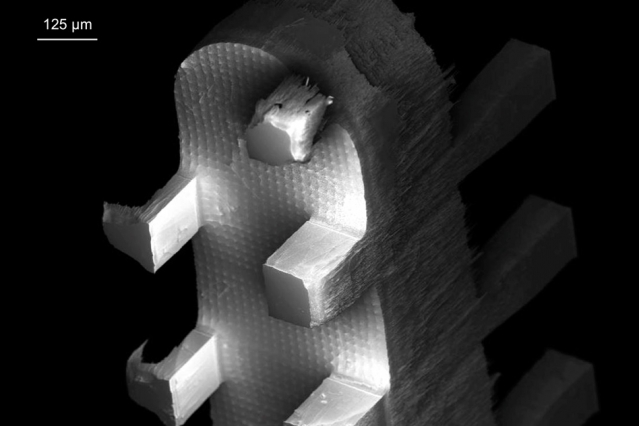Researchers at Massachusetts Institute of Technology (MIT) have developed a novel method for creating nanofibers that boosts the production rate significantly, and at the same time reduces energy usage by over 90%. This latest breakthrough paves the way for producing nanofibers in an efficient and cost-effective way. The study has been published in the latest issue of the journal, Nanotechnology.
 A scanning electron micrograph of the new microfiber emitters, showing the arrays of rectangular columns etched into their sides. Courtesy of the researchers
A scanning electron micrograph of the new microfiber emitters, showing the arrays of rectangular columns etched into their sides. Courtesy of the researchers
Nanofibers are polymer filaments that measure about 200 nm in diameter. These fibers hold promising applications, ranging from fuel cells and solar cells through to water filtration. However, until now, their high cost of production has restricted them to just a few specific industries.
We have demonstrated a systematic way to produce nanofibers through electrospinning that surpasses the state of the art. But the way that it’s done opens a very interesting possibility. Our group and many other groups are working to push 3-D printing further, to make it possible to print components that transduce, that actuate, that exchange energy between different domains, like solar to electrical or mechanical.
We have something that naturally fits into that picture. We have an array of emitters that can be thought of as a dot-matrix printer, where you would be able to individually control each emitter to print deposits of nanofibers.
Luis Fernando Velásquez-García, principal research scientist, Microsystems Technology Laboratories.
Nanofibers can prove useful in applications where a high ratio of surface area to volume is required, for example, fuel cell electrodes that increase reactions at their surfaces, or solar cells that try to increase exposure to sunlight. In addition, nanofibers help in producing materials that are exceptionally strong for their weight, similar to body armor, or that are porous just at small scales, akin to water filters.
Electrospinning, a typical technique used for producing nanofibers, has two versions. In the first approach, a polymer solution is fed through a tiny nozzle and is expanded by a strong electric field. However, this process is relatively slow, and the size of the pump hydraulics limits the number of nozzles for each unit area.
In the other method, a voltage is applied between a collector electrode and a rotating drum enclosed by metal cones. These cones are immersed in a polymer solution, and under the effect of electric field, the solution travels to the apex of the cones and is ultimately emitted toward the electrode in the form of a fiber. However, this method is not reliable and creates uneven length fibers. Voltages as high as 100,000 V are required.
In addition to Velásquez-García, other researchers in this study included Frances Hill, a former postdoc in Velásquez-García’s group who is now at KLA-Tencor; Philip Ponce de Leon, a former master’s student in mechanical engineering; and Eric Heubel, a current postdoc. The team used the second approach on a relatively smaller scale, utilizing methods that are generally employed in the development of microelectromechanical systems to create thick arrays of small emitters.
The compact size of the emitters not only reduces the voltage required to drive them, but also enables more emitters to be assembled together, thereby boosting the production rate. Simultaneously, a nubbly texture imprinted within the sides of the emitters controls the flow of fluid toward their tips, producing fibers of uniform lengths even at high production rates.
"We did all kinds of experiments, and all of them show that the emission is uniform," added Velásquez-García.
Velásquez-García and his team used a deep reactive-ion etching technique to design their emitters. Thick arrays of extremely small rectangular columns were etched on both sides of a silicon wafer. These columns controlled the rate at which the fluid flowed toward the emitters’ sides. Sawtooth patterns were cut from the wafer and placed vertically, with their bases dipped in a solution of dissolved polymer, deionized water and ethanol.
After mounting an electrode in front of the sawteeth and applying a voltage between them, the mixture of water and ethanol streamed in an upward direction, taking polymer chains along with it. The water-ethanol mixture instantly dispersed and left a mesh of polymer filaments opposite individual emitter on the electrode.
The research team packed 225 emitters, measuring a few millimeters in length, on a square chip of approximately 35 mm on a side. At a low voltage of 8,000 V, that device was able to produce many more fibers for each unit area, just like commercially available electrospinning devices.
"The work is an elegant and creative way of demonstrating the strong capability of traditional MEMS [microelectromechanical-systems] fabrication processes toward parallel nanomanufacturing. There is an increased potential to scale it up while maintaining the integrity and accuracy by which the processing method is applied," said Reza Ghodssi, a professor of electrical engineering at the University of Maryland.